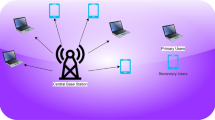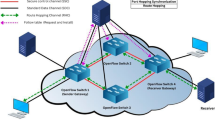Abstract
Nowadays, wireless mesh networks are known as important parts of different commercial, scientific, and industrial processes. Their prevalence increases day-by-day and the future of the world is associated with such technologies for better communication. However, the issue of improving quality of service for dealing with more complex and intense flow of data has been always a remarkable research problem, as a result of improved wireless communication systems. In this sense, objective of this study is to provide a new algorithm for contributing to the associated literature. In the study, peer to peer wireless mesh networks and the concept of service quality were examined first and then an approach for improving service quality in such networks has been proposed accordingly. In detail, the proposed an approach allows profiting data transfer capability by data packet and using this information for routing and preventing overcrowd in network nodes and finally, distributing the load over it. When middle nodes overcrowd, they withhold to send control messages of route creating or do that by delay. The proposed approach has been evaluated and the findings revealed that at least 10% of undue delays through network can be prevented while permittivity does not reduce, thanks to the approach. Also energy consumption within network nodes partially increases due to adding table and the search which can be overlooked.







Similar content being viewed by others
Change history
16 May 2019
A Correction to this paper has been published: https://doi.org/10.1007/s11276-019-02016-4
References
Wang, T., Yang, Q., Tan, K., et al. (2018). DCAP: Improving the capacity of WiFi networks with distributed cooperative access points. IEEE Transactions on Mobile Computing, 17(2), 320–333.
Chang, N., Rashidzadeh, R., & Ahmadi, M. (2010). Robust indoor positioning using differential Wi-Fi access points. IEEE Transactions on Consumer Electronics, 56(3), 1860–1867.
Koo, J., & Cha, H. (2011). Localizing WiFi access points using signal strength. IEEE Communications Letters, 15(2), 187–189.
Heegard, C., Coffey, J. T., Gummadi, S., Murphy, P. A., Provencio, R., Rossin, E. J., et al. (2001). High performance wireless Ethernet. IEEE Communications Magazine, 39(11), 64–73.
Judd, G., & Steenkiste, P. (2002). Fixing 802. 11 access point selection. ACM SIGCOMM Computer Communication Review, 32(3), 31.
Jones, K., Liu, L. (2007). What where wi: An analysis of millions of wi-fi access points. In Portable information devices, 2007. PORTABLE 07. IEEE international conference on (pp. 1–4). IEEE.
Akyildiz, I. F., Wang, X., & Wang, W. (2005). Wireless mesh networks: A survey. Computer Networks, 47(4), 445–487.
Alotaibi, E., & Mukherjee, B. (2012). A survey on routing algorithms for wireless ad-hoc and mesh networks. Computer Networks, 56(2), 940–965.
Hossain, E., & Leung, K. K. (Eds.). (2007). Wireless mesh networks: Architectures and protocols. Berlin: Springer.
Misra, S., Misra, S. C., & Woungang, I. (Eds.). (2009). Guide to wireless mesh networks (vol. 995). Berlin: Springer.
Singh, M. (2019). Wireless mesh networks architecture. In Node-to-node approaching in wireless mesh connectivity (pp. 11–14). Springer, Singapore.
Comer, D. E. (2018). The internet book: Everything you need to know about computer networking and how the Internet works. London: Chapman and Hall/CRC.
Loo, J., Mauri, J. L., & Ortiz, J. H. (Eds.). (2016). Mobile ad hoc networks: Current status and future trends. London: CRC Press.
Aggelou, G. (2008). Wireless mesh networking. New York: McGraw-Hill Professional.
Held, G. (2005). Wireless mesh networks. Philadelphia, PA: Auerbach Publications.
Crow, B. P., Widjaja, I., Kim, J. G., & Sakai, P. T. (1997). IEEE 802.11 wireless local area networks. IEEE Communications Magazine, 35(9), 116–126.
Cali, F., Conti, M., & Gregori, E. (1998). IEEE 802.11 wireless LAN: Capacity analysis and protocol enhancement. In INFOCOM’98. Seventeenth annual joint conference of the IEEE computer and communications societies. Proceedings. IEEE (vol. 1, pp. 142–149). IEEE.
O’hara, B., & Petrick, A. (2005). IEEE 802.11 handbook: A designer’s companion. IEEE Standards Association.
Xiao, Y., & Rosdahl, J. (2002). Throughput and delay limits of IEEE 802.11. IEEE Communications Letters, 6(8), 355–357.
Kumar, K. A., & Balakrishna, R. (2017). Comparative analysis of delay and throughput using IEEE 802.11 and receiver centric-MAC protocol in wireless sensor networks. In Power and advanced computing technologies (i-PACT), 2017 Innovations in (pp. 1–5). IEEE.
Goode, B. (2002). Voice over internet protocol (VoIP). Proceedings of the IEEE, 90(9), 1495–1517.
Ahson, S. A., & Ilyas, M. (Eds.). (2008). VoIP handbook: Applications, technologies, reliability, and security. London: CRC Press.
Ganguly, S., & Bhatnagar, S. (2008). VoIP: Wireless, P2P and new enterprise voice over IP. London: Wiley.
Geer, D. (2009). The future of mobile VoIP in the enterprise. Computer, 42(6), 15–18.
Kaushal, S., Kumar, H., Singh, S., Aggarwal, S., Kaur, J., & Vaidyanathan, S. (2018). Modelling and simulation of an analytical approach to handle real-time traffic in VoIP network. International Journal of Simulation and Process Modelling, 13(1), 35–42.
Jiang, Y., & Tang, S. (2017). An efficient and secure VoIP communication system with chaotic mapping and message digest. Multimedia Systems, 24(3).
Is4Profit.com. (2012). Using VoIP to increase efficiency and reduce costs. Is4Profit.com Web—Tech. Online: http://is4profit.com/using-voip-to-increase-efficiency-and-reduce-costs/. Accessed on 28th Dec 2018.
Chu, C. Y., Chen, S., Yen, Y. C., Yeh, S. L., Chu, H. H., & Huang, P. (2018). EQ: A QoE-centric rate control mechanism for VoIP calls. ACM Transactions on Modeling and Performance Evaluation of Computing Systems (TOMPECS), 3(1), 4.
Harkat, Y., & Amrouche, A. (2012). A comparative evaluation of VoWLAN call capacity with and without codec’s silence suppression. In Microelectronics (ICM), 2012 24th International Conference on (pp. 1–4). IEEE.
Ulseth, T., & Engelstad, P. (2006). Voice over WLAN (VoWLAN): A wireless voice alternative. TELEKTRONIKK, 102(1), 82.
Badia, L., Merlin, S., Zanella, A., & Zorzi, M. (2006). Pricing VoWLAN services through a micro-economic framework. IEEE Wireless Communications, 13(1), 6–13.
Ghaderzadeh, A., Kargahi, M., & Reshadi, M. (2018). ReDePoly: Reducing delays in multi-channel P2P live streaming systems using distributed intelligence. Telecommunication Systems, 67(2), 231–246.
Merani, M. L., & Natali, L. (2016). Adaptive streaming in P2P live video systems: A distributed rate control approach. ACM Transactions on Multimedia Computing, Communications, and Applications (TOMM), 12(3), 46.
Qiu, D., & Srikant, R. (2004). Modeling and performance analysis of BitTorrent-like peer-to-peer networks. In ACM SIGCOMM computer communication review (vol. 34, no. 4, pp. 367–378). ACM.
Lan, H. B. T., & Nguyen, H. S. (2011). A low-delay push-pull based application layer multicast for p2p live video streaming. In 2011 Third international conference on knowledge and systems engineering (pp. 104–111). IEEE.
Narkdej, K., Choochaisri, S., & Intanagonwiwat, C. (2011). A reinforcement-based push-pull approach for peer-to-peer live streaming. In Wireless communications, networking and mobile computing (WiCOM), 2011 7th international conference on (pp. 1–4). IEEE.
Brogle, M., Milic, D., Bettosini, L., & Braun, T. (2009). A performance comparison of native IP Multicast and IP Multicast tunneled through a Peer-to-Peer overlay network. In Ultra modern telecommunications and workshops, 2009. ICUMT’09. International conference on (pp. 1–6). IEEE.
Ferreira, F. H., da Silva, A. P. C., & Vieira, A. B. (2016). Characterizing peers communities and dynamics in a P2P live streaming system. Peer-to-Peer Networking and Applications, 9(1), 1–15.
Pal, K., Govil, M. C., & Ahmed, M. (2019). Utilization-based hybrid overlay for live video streaming in P2P network. In Recent findings in intelligent computing techniques (pp. 331–338). Springer, Singapore.
Al-Maqri, M. A., Alrshah, M. A., & Othman, M. (2018). Review on QoS provisioning approaches for supporting video traffic in IEEE802. 11e: Challenges and issues. IEEE Access, 6, 55202–55219.
Felber, P., Kermarrec, A. M., Leonini, L., Riviere, E., & Voulgaris, S. (2012). PULP: An adaptive gossip-based dissemination protocol for multi-source message streams. Peer-to-Peer Networking and Applications, 5(1), 74–91.
Perkins, C., Belding-Royer, E., & Das, S. (2003). Ad hoc on-demand distance vector (AODV) routing. No. RFC 3561.
Perkins, C. E. (2001). Ad hoc networking (Vol. 1). Reading: Addison-Wesley.
Muhammad, A. R. I. F., Guojun, W. A. N. G., & Valentina, Emilia B. A. L. A. S. (2018). Secure VANETs: Trusted communication scheme between vehicles and infrastructure based on fog computing. Studies in Informatics and Control, 27(2), 235–246.
Royer, E. M., & Toh, C. K. (1999). A review of current routing protocols for ad hoc mobile wireless networks. IEEE Personal Communications, 6(2), 46–55.
Gheisari, M., et al. (2017). MAPP: A modular arithmetic algorithm for privacy preserving in IoT. In Ubiquitous computing and communications (ISPA/IUCC), 2017 IEEE international symposium on parallel and distributed processing with applications and 2017 IEEE international conference on. IEEE.
Abolhasan, M., Wysocki, T., & Dutkiewicz, E. (2004). A review of routing protocols for mobile ad hoc networks. Ad Hoc Networks, 2(1), 1–22.
AL-Dhief, F. T., Sabri, N., Salim, M. S., Fouad, S., & Aljunid, S. A. (2018). MANET routing protocols evaluation: AODV, DSR and DSDV perspective. In MATEC web of conferences (vol. 150, p. 06024). EDP Sciences.
Tseng, C. Y., Balasubramanyam, P., Ko, C., Limprasittiporn, R., Rowe, J., & Levitt, K. (2003). A specification-based intrusion detection system for AODV. In Proceedings of the 1st ACM workshop on security of ad hoc and sensor networks (pp. 125–134). ACM.
Ade, S. A., & Tijare, P. A. (2010). Performance comparison of AODV, DSDV, OLSR and DSR routing protocols in mobile ad hoc networks. International Journal of Information Technology and Knowledge Management, 2(2), 545–548.
Cai, S., Bao, G., Ma, X., Wu, W., Bian, G., Rodrigues, J. J., & de Albuquerque, V. H. C. (2019). Parameters optimization of the dust absorbing structure for photovoltaic panel cleaning robot based on orthogonal experiment method. Journal of Cleaner Production.
Casas-Ramírez, M. S., & Camacho-Vallejo, J. F. (2017). Solving the p-median bilevel problem with order through a hybrid heuristic. Applied Soft Computing, 60, 73–86.
Kabalci, Y. (2018). An improved approximation for the Nakagami-m inverse CDF using artificial bee colony optimization. Wireless Networks, 24(2), 663–669.
Torres-Escobar, R., Marmolejo-Saucedo, J. A., & Litvinchev, I. (2018). Binary monkey algorithm for approximate packing non-congruent circles in a rectangular container. Wireless Networks, 1–10.
George, R., & Hemanth, J. (2011). Application of an optimization algorithm for channel assignment in mobile communication. In IJCA special issue on “novel aspects of digital imaging applications” DIA, 29–35.
Hildmann, H., Atia, D. Y., Ruta, D., Khrais, S. S., & Isakovic, A. F. (2019). A model for wireless-access network topology and a PSO-based approach for its optimization. In Recent advances in computational optimization (pp. 87–116). Springer, Cham.
Acknowledgements
The authors would like to send special thanks to the Islamic Azad University of Iran for the great support in the research introduced in this study.
Author information
Authors and Affiliations
Corresponding author
Additional information
Publisher's Note
Springer Nature remains neutral with regard to jurisdictional claims in published maps and institutional affiliations.
The original version of this article was revised: The third author name was incorrect. This has been corrected in this version.
Rights and permissions
About this article
Cite this article
Gheisari, M., Alzubi, J., Zhang, X. et al. A new algorithm for optimization of quality of service in peer to peer wireless mesh networks. Wireless Netw 26, 4965–4973 (2020). https://doi.org/10.1007/s11276-019-01982-z
Published:
Issue Date:
DOI: https://doi.org/10.1007/s11276-019-01982-z




